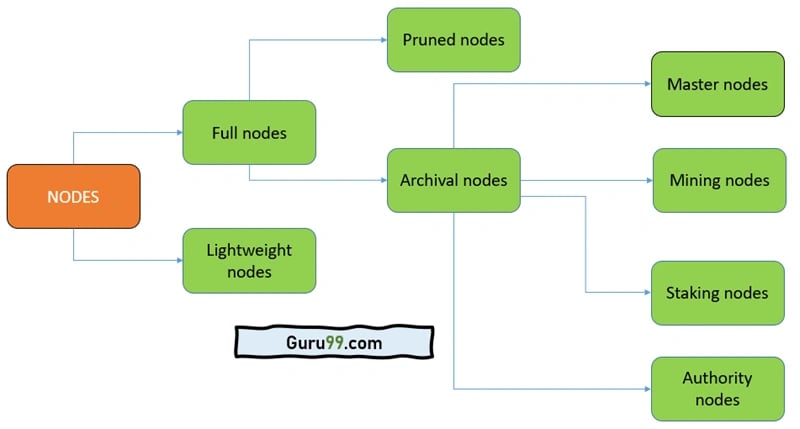위키 구독하기
Share wiki
Bookmark
Node
에이전트 토큰화 플랫폼 (ATP):에이전트 개발 키트(ADK)로 자율 에이전트 구축
Node
노드(Node) 또는 블록체인 노드는 일반적으로 컴퓨터인 장치로, 블록체인 네트워크에 참여합니다. 블록체인 프로토콜 소프트웨어를 실행하여 트랜잭션 검증 및 네트워크 보안 유지에 기여합니다. 노드들은 서로 통신하며, 노드 수가 많을수록 네트워크는 더욱 분산됩니다.[4]
노드는 네트워크 참여자로서 모든 트랜잭션을 기록하는 디지털 원장인 블록체인의 검증, 전파 및 유지에 기여합니다. [2]
개요
블록체인 노드의 주요 역할은 트랜잭션의 브로드캐스팅 및 검증입니다. 사용자가 트랜잭션을 제출하면 노드가 이를 수신하여 네트워크의 나머지 부분에 브로드캐스팅합니다. 네트워크의 모든 노드는 송신자가 사용 가능한 자금을 보유하고 있으며 해당 자금을 보낼 권한이 있는지 확인합니다.
모든 노드가 트랜잭션을 검증한다는 사실은 네트워크 보안에 도움이 됩니다. 잘못된 트랜잭션은 노드의 51%가 확인한 경우에만 승인될 수 있습니다. 수백 또는 수천 개의 노드가 있는 블록체인 네트워크에서는 악의적인 행위자가 51%를 장악할 가능성이 매우 낮습니다.
노드에 의해 새로운 트랜잭션이 검증되면 블록으로 그룹화됩니다. 각각의 새로운 블록은 해당 합의 메커니즘의 규칙에 따라 블록체인에 추가되며, 이러한 규칙은 전체 노드라고 하는 특정 노드에 의해 적용됩니다. [4]
기능
트랜잭션 검증
노드는 블록체인에 추가되기 전에 트랜잭션의 유효성을 검증할 책임이 있습니다. 이 검증 프로세스에는 암호화 서명을 확인하고 송신자가 트랜잭션을 완료하는 데 필요한 자금을 보유하고 있는지 확인하는 작업이 포함됩니다.
합의 메커니즘
노드는 작업 증명(PoW) 또는 지분 증명(PoS)과 같은 합의 메커니즘을 사용하여 블록체인의 상태에 대해 공동으로 합의합니다. 이러한 합의는 이중 지출 및 악의적인 공격을 방지합니다.
원장 유지
각 노드는 전체 블록체인 원장의 사본을 저장합니다. 이러한 중복성은 일부 노드에서 기술적 문제나 공격이 발생하더라도 데이터가 손상되지 않도록 합니다. 여러 노드에 걸쳐 원장이 분산되는 것은 네트워크의 복원력과 내결함성에 기여합니다.
네트워크 전파
새로운 트랜잭션이 시작되면 노드는 네트워크 전체에 이 정보를 전달하는 데 중요한 역할을 합니다. 이를 통해 모든 노드가 최신 트랜잭션 데이터로 업데이트되어 동기화 및 일관성을 유지합니다. [3]
유형
블록체인 노드는 수행하는 기능에 따라 그룹화됩니다. 차이점에도 불구하고 모든 노드는 네트워크의 무결성을 유지하기 위해 노력합니다. [1][3][4]

전체 노드
이러한 노드는 네트워크의 중추입니다. 블록체인의 전체 사본을 유지하고, 트랜잭션 검증에 참여하며, 합의 달성에 기여합니다. 전체 노드는 네트워크의 보안 및 분산에 필수적입니다. [5]
축소 전체 노드
축소 전체 노드는 설정된 메모리 제한으로 알려져 있습니다. 노드는 설치 시 전체 블록체인을 다운로드하고 가장 오래된 블록부터 순서를 유지하기 위해 메타데이터를 제외한 모든 것을 삭제하기 시작하여 용량에 도달할 때까지 최근 항목만 유지합니다. 저장 용량보다 보안을 우선시하기 때문에 원장의 전체 사본을 보유하지 않습니다.
보관 전체 노드
보관 전체 노드는 생성 블록까지 모든 트랜잭션을 기록하는 전체 블록체인 원장을 저장합니다.
마스터 노드
마스터노드는 체인에 새로운 블록을 추가할 수 없는 전체 노드입니다. 마스터 노드는 트랜잭션을 검증하고 기록을 유지합니다. 이러한 노드는 전체 생태계를 안정화하고 보호하며 개인 트랜잭션, 즉시 트랜잭션, 재무 관리 및 자금 조달, 거버넌스 투표와 같은 서비스를 제공합니다.
Dash는 2014년 네트워크 메커니즘에 마스터노드를 처음 사용한 블록체인입니다.
채굴 노드
PoW 기반 네트워크에서 채굴 노드는 새로운 블록을 블록체인에 추가하기 위해 복잡한 수학 퍼즐을 풉니다. 먼저 해결책을 찾기 위해 경쟁하며 암호화폐 토큰과 트랜잭션 수수료로 보상받습니다. 채굴 노드는 네트워크 보안 및 트랜잭션 처리에 중요한 역할을 합니다.
Bitcoin 채굴자는 네트워크에 추가할 새로운 블록을 적극적으로 찾습니다. 새로운 블록이 추가되면 보상을 받습니다. [6]
권한 노드
권한 노드는 사설 또는 부분적으로 중앙 집중식 블록체인의 관리자 역할을 하도록 커뮤니티에서 선출됩니다.
스테이킹 노드
이러한 노드는 인증 프로세스에 '스테이킹'이라는 방법을 사용합니다. 담보로 잠긴 자금을 사용하여 지분 증명 합의 모델은 특정 양의 토큰을 프로토콜에 기여하거나 네트워크에서 특정 시간 동안 로그인하는 것과 같은 미리 정해진 지표를 충족한 참가자에게 무작위로 인증 권한을 부여합니다. [6]
경량 노드(SPV 노드)
SPV(Simplified Payment Verification) 노드는 모바일 장치와 같은 리소스 제약 환경을 위해 설계되었으며 전체 블록체인을 저장하지 않습니다. 대신 전체 노드에 의존하여 트랜잭션을 검증하고 트랜잭션이 블록에 포함되었다는 증명을 제공하지만 블록 자체는 저장하지 않습니다.
라이트닝 노드
네트워크 정체를 해소하기 위해 라이트닝 노드는 별도의 네트워크 외부 연결을 통해 오프체인 트랜잭션을 실행합니다. 처리되면 트랜잭션이 메인 블록체인에 추가됩니다. 이러한 해결 방법은 네트워크 부하를 줄이면서 저렴하고 즉각적인 교환을 가능하게 합니다.
슈퍼 노드
슈퍼 노드는 프로토콜 변경 구현 또는 프로토콜 유지 관리와 같은 특수 작업을 수행하기 위해 필요에 따라 생성됩니다. 블록체인 트랜잭션 데이터와 추가적인 이력 정보를 전송합니다.
Bitcoin 노드에는 모든 노드 호스트가 볼 수 있는 슈퍼노드가 있습니다. [6][7]
책임
분산화
노드는 네트워크 전체에 제어를 분산하여 중앙 권한의 필요성을 제거합니다. 이러한 분산화는 보안을 강화하고 단일 장애 지점을 방지하며 시스템에 대한 신뢰를 높입니다.
검열 저항성
분산된 특성으로 인해 노드는 검열을 어렵게 만듭니다. 일부 노드가 손상되더라도 상당수의 노드가 정직하고 작동하는 한 네트워크는 계속 작동할 수 있습니다.
보안
트랜잭션 검증 및 합의 달성에 대한 노드의 공동 노력은 블록체인 네트워크의 보안을 강화합니다. 이러한 보안은 신뢰가 가장 중요한 금융 애플리케이션에서 특히 중요합니다. [4]
잘못된 내용이 있나요?
